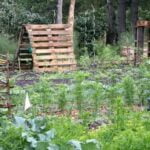Are you looking to improve your vegetable gardening experience? In this article, we will guide you on how to build raised beds for vegetable gardening, a method that offers numerous benefits for gardeners of all levels. Raised beds provide better drainage, warmer soil, and improved accessibility, making them an ideal choice for growing your favorite vegetables.
When it comes to vegetable gardening, the location is crucial to success. We will discuss the perfect spot for building raised beds, taking into consideration factors such as sunlight, water drainage, and accessibility. Additionally, we will explore the different material options available – from wood to composite to stone – and their respective advantages and disadvantages so you can make an informed decision.
Planning and measuring are critical steps in building raised beds. Our step-by-step guidance will help you plan and measure the area for the raised beds while considering their size and shape. We will also break down the construction process, from assembling the frame to filling them with soil. Whether you’re a beginner or experienced gardener, our article will provide valuable insights into creating successful raised beds for vegetable gardening.
Selecting the Perfect Location
When it comes to building raised beds for vegetable gardening, selecting the perfect location is crucial for the success of your garden. The ideal spot for building raised beds should take into consideration factors such as sunlight, water drainage, and accessibility. Here are some important tips to keep in mind when choosing the location for your raised beds:
- Sunlight: Choose a location that receives at least 6-8 hours of direct sunlight per day. This will ensure that your vegetables have access to the necessary sunlight for healthy growth and productivity.
- Water Drainage: Avoid areas with poor drainage, as excess water can lead to root rot and other issues. Look for a spot with good water drainage to prevent waterlogging in your raised beds.
- Accessibility: Consider the proximity of your raised beds to a water source and ease of access for maintenance tasks such as weeding, watering, and harvesting.
Once you have identified the perfect location for your raised beds, you can move on to the next step of building them using the chosen materials and following proper measurements. By carefully selecting the location based on sunlight, water drainage, and accessibility, you will set yourself up for a successful vegetable gardening experience.
Remember that these factors are crucial in ensuring that your vegetables thrive in their new environment. By taking these considerations into account, you’ll be well on your way to creating a thriving vegetable garden in your perfectly chosen spot.
Choosing the Right Materials
When it comes to building raised beds for vegetable gardening, one of the key decisions you’ll need to make is choosing the right materials for construction. There are several options available, including wood, composite, and stone, each with its own set of pros and cons. Understanding the characteristics of each material can help you make an informed decision that suits your specific gardening needs.
Wooden raised beds are a popular choice due to their affordability and ease of customization. They can be easily constructed in various sizes and shapes, making them versatile for different garden layouts. However, wood may deteriorate over time due to exposure to moisture and pests, so using rot-resistant varieties like cedar or redwood is recommended for longevity.
Another option is composite materials, which are made from a blend of wood fibers and recycled plastics. This type of raised bed offers the natural look of wood with added durability and resistance to decay. While composite materials tend to be more expensive upfront, they require minimal maintenance and have a longer lifespan compared to traditional wood beds.
For those looking for a more permanent and decorative option, stone or masonry raised beds provide excellent durability and aesthetic appeal. They can withstand harsh weather conditions and won’t rot or deteriorate over time. However, building stone beds requires specialized skills and equipment, making them a more labor-intensive and costly choice.
Understanding the benefits and drawbacks of different materials is crucial in deciding how to build raised beds for vegetable gardening. By carefully considering factors such as budget, longevity, maintenance requirements, and aesthetic preferences, you can select the most suitable material that aligns with your gardening goals.
Planning and Measuring
When it comes to building raised beds for vegetable gardening, proper planning and measuring are crucial steps to ensure a successful and productive garden. Before embarking on the construction of your raised beds, it’s important to take into account several considerations such as size, shape, and layout.
This section will provide step-by-step guidance on how to plan and measure the area for your raised beds in order to optimize the space and create an ideal environment for your vegetables to thrive.
First and foremost, consider the size of the area where you intend to build your raised beds. Measure the length and width of the space to determine the dimensions of your raised bed. Keep in mind that wider beds make it easier to reach across without stepping into the soil, while narrower beds may be more suitable for smaller spaces.
Next, think about the shape of your raised beds. While rectangular or square-shaped beds are more common, consider incorporating curves or irregular shapes to add visual interest to your garden. When planning the shape, make sure there is adequate space between each bed for easy access and maintenance.
In addition to size and shape considerations, take into account any pre-existing features in your garden such as trees, shrubs, or existing landscaping. Ensure that there is sufficient distance between these elements and your raised beds. Make sure you also plan for pathways between each bed for accessibility.
Properly planning and measuring the area for your raised beds will set the foundation for a successful vegetable garden. Taking these factors into consideration will help you optimize space while creating an ideal environment for growing an abundance of fresh produce.
| Consideration | Guidance |
|---|---|
| Size | Measure the length and width of the space |
| Shape | Consider incorporating curves or irregular shapes |
| Layout | Take into account any pre-existing features in your garden |
Building the Raised Beds
Raised beds are a popular and efficient way to grow vegetables in your garden. They offer many benefits, including improved soil drainage, better control over the soil composition, and easier access for planting, weeding, and harvesting. If you’re interested in learning how to build raised beds for vegetable gardening, here is a step-by-step guide to help you get started.
First, you’ll need to gather the necessary materials for building your raised beds. You can choose from a variety of options such as wood, composite, or stone.
Each material has its own pros and cons, so make sure to consider factors like cost, durability, and appearance before making your decision. Once you have selected the material that best suits your needs and preferences, it’s time to start planning and measuring the area where the raised beds will be located.
Next, you will need to determine the size and shape of your raised beds based on the available space in your garden and the types of vegetables you plan to grow. After planning and measuring the area, you can start building the frames for your raised beds. Assemble the frame according to your measurements using the selected materials.
Once the frames are assembled, it’s time to fill them with soil. Make sure to use high-quality soil that is suitable for vegetable gardening. You can also add compost or organic matter to improve the soil structure and fertility. By following these steps and maintaining good irrigation systems, you’ll be well on your way to successful vegetable gardening in your new raised beds.
Adding Irrigation Systems
When it comes to vegetable gardening, proper irrigation is key to ensuring the health and productivity of your plants. Raised beds offer unique opportunities for irrigation systems that can maximize water efficiency and plant growth. In this section, we will explore the benefits of adding irrigation systems to raised beds and provide guidance on installation and maintenance.
The Benefits of Irrigation Systems in Raised Beds
Irrigation systems in raised beds offer numerous benefits. They ensure that water is delivered directly to the roots of the plants, reducing water waste through evaporation. Additionally, automated irrigation systems can save time and effort by providing consistent watering without the need for manual intervention. This is especially helpful during hot summer months or when you are away from home. By maintaining optimal soil moisture levels, irrigation systems can also help prevent certain plant diseases and promote healthy root development.
Installation and Maintenance Guidance
There are several types of irrigation systems that can be installed in raised beds, including drip irrigation, soaker hoses, or micro-sprinklers. Before installing an irrigation system, it’s important to consider factors such as water pressure, coverage area, and the specific needs of your crops. When installing the system, ensure that it is positioned properly within the raised bed to deliver water evenly across the entire growing area.
Maintenance of the irrigation system is crucial for its long-term effectiveness. Regularly check for any clogs or leaks in the system and make adjustments as needed to ensure even distribution of water. Depending on your local climate and soil conditions, you may need to adjust the frequency and duration of watering to accommodate changes in weather patterns or plant growth stages.
By incorporating an efficient irrigation system into your raised beds for vegetable gardening, you can significantly enhance the success of your garden while conserving water resources.
Planting and Maintaining
When it comes to planting in raised beds, there are several factors to consider to ensure a successful vegetable garden. The type of vegetables you choose to grow will depend on your local climate, the season, and the amount of sunlight your raised beds receive. Some popular choices for raised bed gardening include tomatoes, peppers, lettuce, carrots, and herbs. It’s important to research which vegetables thrive in your specific area and plan accordingly.
Choosing the Right Vegetables
When planning what to plant in your raised beds, consider the space available and how much each plant will produce. Some vegetables, like zucchini and squash, can take up a lot of space and may not be ideal for smaller raised beds. Additionally, think about companion planting – certain plants do better when planted together due to their ability to repel pests or enhance growth.
Ongoing Maintenance
Once you’ve planted your vegetables, it’s essential to stay on top of maintenance tasks to ensure a healthy garden. This includes watering regularly, especially during dry spells, and monitoring for signs of pests or disease. Raised beds can also require additional nutrients over time as the soil settles and depletes its original nutrients. Consider using organic fertilizers or compost to replenish the soil and keep your plants thriving.
Additional Tips
Consider utilizing trellises or cages for climbing plants like cucumbers or tomatoes – this will help maximize space in your raised beds while keeping these plants healthy. Lastly, be sure to rotate crops each growing season to prevent depletion of nutrients from the soil and reduce the risk of disease. By planning carefully and staying vigilant with maintenance tasks, you can enjoy a bountiful harvest from your raised bed vegetable garden.
Troubleshooting
In conclusion, building raised beds for vegetable gardening can be a rewarding endeavor that offers numerous benefits. From improved drainage to better soil quality, raised beds provide an ideal environment for growing a variety of vegetables. By selecting the perfect location with ample sunlight and good water drainage, choosing the right materials, and adding irrigation systems, you can create the perfect setup for your vegetable garden.
Once you have built your raised beds, it’s important to consider what to plant in them and how to maintain them. By following proper planting and maintenance practices, you can enjoy a bountiful harvest of fresh vegetables throughout the growing season. Additionally, understanding common issues that may arise with raised beds and having solutions ready will help ensure successful vegetable gardening.
Incorporating raised beds into your vegetable garden allows for better control over soil conditions and offers an efficient use of space. With careful planning, construction, and ongoing care, you can create a thriving vegetable garden in your own backyard. Whether you are new to gardening or looking to revamp your current setup, following these steps on how to build raised beds for vegetable gardening will set you on the path to a plentiful harvest of delicious homegrown produce.
Frequently Asked Questions
How Deep Should a Raised Garden Bed Be for Vegetables?
The ideal depth for a raised garden bed for vegetables is around 6 to 12 inches. This depth allows for enough soil for plant roots to grow while also providing good drainage and aeration for healthy vegetable growth.
What Do You Put in the Bottom of a Raised Vegetable Bed?
In the bottom of a raised vegetable bed, it’s best to put a layer of cardboard or newspaper to help smother any weeds or grass underneath. This will also create a barrier between the new soil and the existing ground, preventing weeds from growing up into the raised bed.
What Kind of Wood Do You Use for Raised Vegetable Beds?
When building raised vegetable beds, using rot-resistant wood is essential to ensure the longevity of the beds. Cedar, redwood, and cypress are popular choices due to their natural resistance to rot and insects. It’s important to avoid pressure-treated wood, as it can leach harmful chemicals into the soil over time, potentially harming your vegetables.

If you’re looking to get into vegetable gardening, or are just looking for some tips on how to make your current garden better, then you’ve come to the right place! My name is Ethel and I have been gardening for years. In this blog, I’m going to share with you some of my best tips on how to create a successful vegetable garden.





